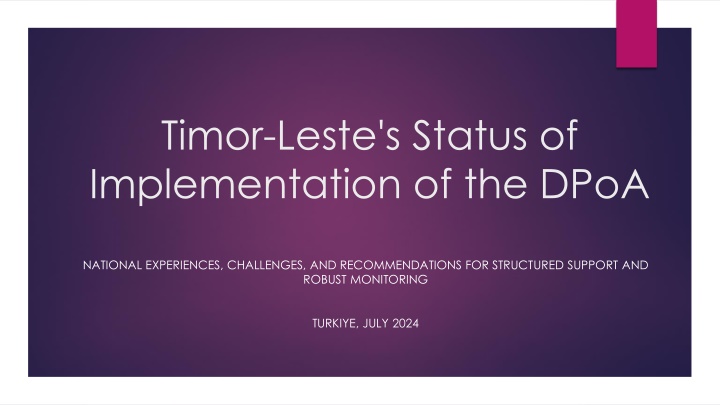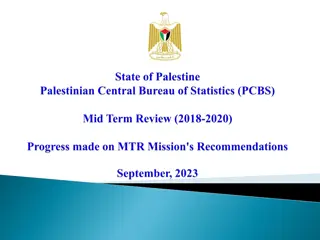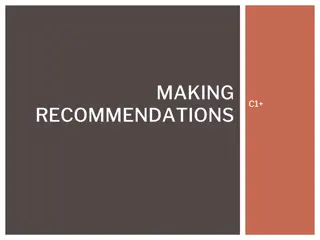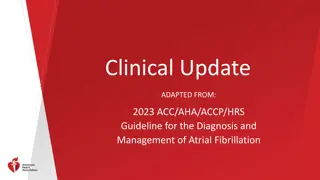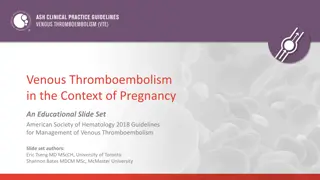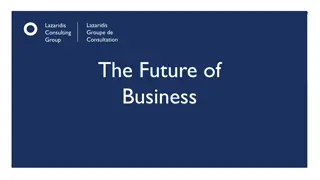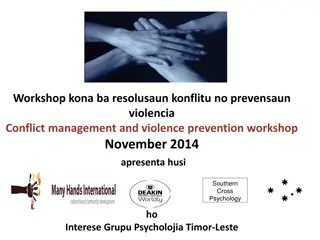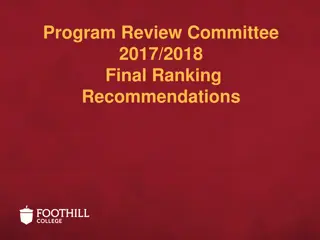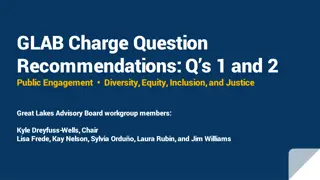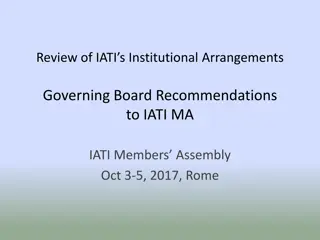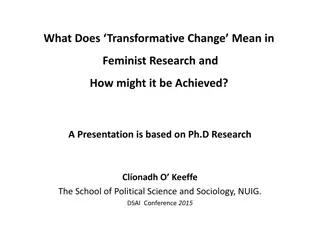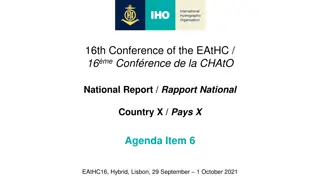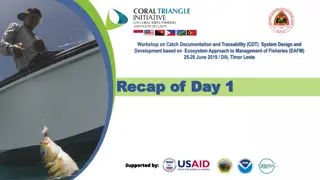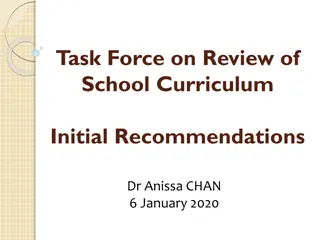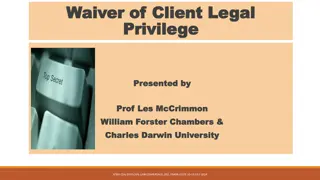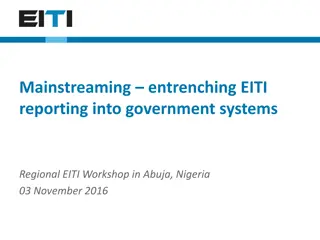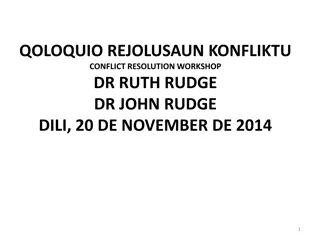Timor-Leste's Development Challenges and Recommendations
Timor-Leste's long-term vision for development is outlined in the Strategic Development Plan 2011-2030, as it strives to achieve the Sustainable Development Goals by 2030. Challenges such as political instability, economic vulnerabilities, and social inequities hinder progress. Recommendations focus on aligning strategies with key focus areas, including poverty reduction, education, healthcare, innovation, and international partnerships.
Download Presentation

Please find below an Image/Link to download the presentation.
The content on the website is provided AS IS for your information and personal use only. It may not be sold, licensed, or shared on other websites without obtaining consent from the author.If you encounter any issues during the download, it is possible that the publisher has removed the file from their server.
You are allowed to download the files provided on this website for personal or commercial use, subject to the condition that they are used lawfully. All files are the property of their respective owners.
The content on the website is provided AS IS for your information and personal use only. It may not be sold, licensed, or shared on other websites without obtaining consent from the author.
E N D
Presentation Transcript
Timor-Leste's Status of Implementation of the DPoA NATIONAL EXPERIENCES, CHALLENGES, AND RECOMMENDATIONS FOR STRUCTURED SUPPORT AND ROBUST MONITORING TURKIYE, JULY 2024
Background and Context Timor-Leste s long-term vision is guided by Timor-Leste s Strategic Development Plan 2011- 2030 (2011) - a twenty year vision that reflects the aspirations of the Timorese people to create a prosperous and strong nation. Timor-Leste adopted the 2030 Agenda and Sustainable Development Goals (2015) and launched a roadmap to implement it in 2017. Substantial progress had been made over the past 20 years but graduating from LDC remains challenging and fully achieving any of the SDGs by 2030 is unlikely under the current development pace. The Second Voluntary National Review of SDG Implementation Progress (2023) and the Committee for Development Policy (CDP) 2024 Triennial Review of Timor-Leste LDC s graduation progress (2023) highlights successes and setbacks.
Aligning DPoA with Timor-Leste SDP DPoA Key Focus Timor-Leste Strategic Development Plan and Roadmap to 2030 Agenda and SDGs SDG 1 (No Poverty): Programs targeting poverty reduction, health, and education initiatives. SDG 4 (Quality Education): Expanding access to education and vocational training. SDG 3 (Good Health and Well-being): Improving healthcare services and infrastructure. SDG 9 (Industry, Innovation, and Infrastructure): Investment in technology and innovation infrastructure. SDG 8 (Decent Work and Economic Growth): Promoting technological advancements to boost economic activities. SDG 4 (Quality Education): Incorporating technology in education systems. SDG 8 (Decent Work and Economic Growth): Economic diversification and support for SMEs. SDG 9 (Industry, Innovation, and Infrastructure): Developing robust infrastructure to support economic activities. SDG 10 (Reduced Inequality): Inclusive growth initiatives to reduce disparities. SDG 17 (Partnerships for the Goals): Enhancing regional and international cooperation. SDG 9 (Industry, Innovation, and Infrastructure): Developing trade infrastructure. SDG 8 (Decent Work and Economic Growth): Promoting export-led growth and regional trade partnerships. 1. Investing in people to eradicate poverty and build capacity 2. Leveraging science, technology, and innovation for sustainable development 3. Supporting structural transformation for prosperity 4. Enhancing international trade and regional integration 5. Addressing climate change, environmental degradation, and building resilience against future shocks 6. Mobilizing international solidarity and partnerships for sustainable graduation SDG 13 (Climate Action): Climate change mitigation and adaptation strategies. SDG 15 (Life on Land): Sustainable management of natural resources. SDG 14 (Life Below Water): Marine conservation efforts. SDG 7 (Affordable and Clean Energy): Promoting renewable energy sources. SDG 17 (Partnerships for the Goals): Building global partnerships to support sustainable development. SDG 10 (Reduced Inequality): Efforts to create equitable international relationships. SDG 16 (Peace, Justice, and Strong Institutions): Strengthening institutions through international support.
Common Challenges Political Will and Commitment: political instability hinders progress in meeting the targets. Economic Vulnerabilities: Heavy reliance on a narrow range of exports, leading to economic instability. Limited access to international markets and trade barriers. Social Inequities: Persistent poverty, inequality, and limited health facilities. Challenges in reaching marginalized and remote communities with essential services. Institutional Weaknesses: Weak governance structures and limited institutional capacity. Inefficiencies in public administration. Vulnerable to the impacts of natural hazards and climate change.
Lessons Learned Community Engagement: Importance of involving local communities in planning and implementation. Ensuring that development initiatives are Country Lead, Country owned , culturally relevant and locally owned. Capacity Building: Continuous investment in human resources and institutional capacity. Strengthening local institutions to enhance governance and service delivery. Policy Coherence and Sequencing: Aligning national policies with DPoA objectives for better outcomes. Coordinating efforts across different sectors and stakeholders.
Lessons Learned Integrated Approaches: Combining efforts across education, health, and economic development. Holistic strategies that address multiple dimensions of poverty and development. Partnerships and Collaboration: Engaging with international partners, NGOs, and the private sector. Leveraging global networks for technical assistance and funding. Monitoring and Evaluation: Establishing robust M&E frameworks to track progress, outcomes and adapt strategies. Using data and evidence to inform decision-making and policy adjustments eg. Census fo Fila Fali and Dalan ba Futuru Timor-Leste information system to track budget allocations towards each SDGs targets.
Recommendations for Enhancing DPoA Implementation Enhancing Financial Support: Increasing ODA (Official Development Assistance) and mobilizing domestic resources. Facilitating access to concessional financing and investment, particularly assist in adapting to climate-related disasters. Strengthening Global Partnerships: Building strong alliances with development partners and international organizations. Promoting South-South and triangular cooperation for knowledge exchange. Fostering Innovation and Technology Transfer: Encouraging innovation through supportive policies and incentives. Facilitating technology transfer and capacity building in critical sectors.
Thank you .! Obrigado wa in.!
